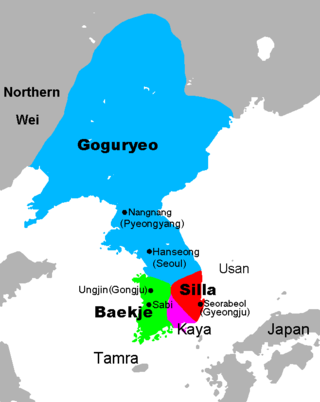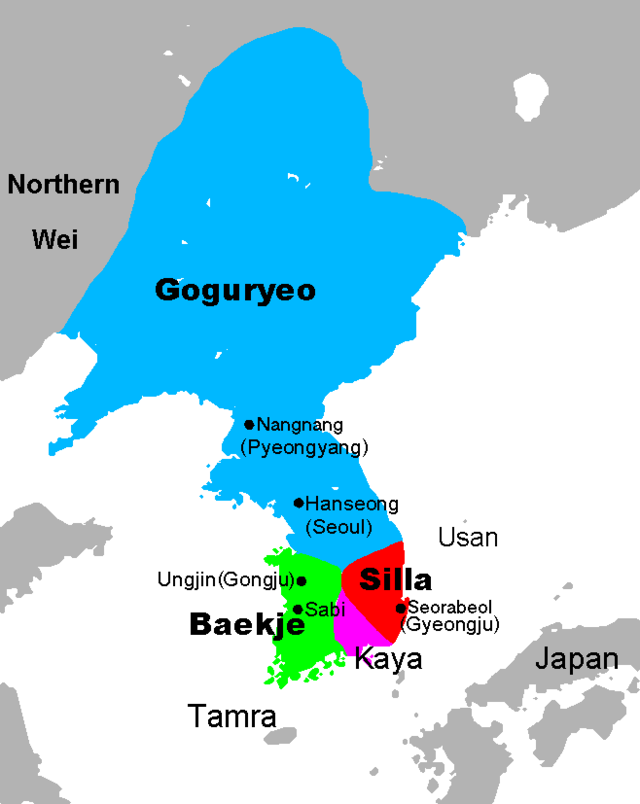Top Qs
Timeline
Chat
Perspective
Baekje language
Language of Baekje From Wikipedia, the free encyclopedia
Remove ads
The language of the kingdom of Baekje (4th–7th centuries), one of the Three Kingdoms of Korea, is poorly attested, and scholars differ on whether one or two languages were used. However, at least some of the material appears to be a variety of Old Korean.[1]
Remove ads
Description in early texts
Summarize
Perspective
Baekje was preceded in southwestern Korea by the Mahan confederacy. The Chinese Records of the Three Kingdoms (3rd century) states that the Mahan language differed from that of Goguryeo to the north and the other Samhan ('Three Han') to the east, Byeonhan and Jinhan, whose languages were said to resemble each other. However, the Book of the Later Han (5th century) speaks of differences between the languages of Byeonhan and Jinhan.[2]
Historians believe that Baekje was established by immigrants from Goguryeo who took over Mahan, while Byeonhan and Jinhan were succeeded by Gaya and Silla respectively. According to Book of Liang (635), the language of Baekje was similar to that of Goguryeo.[3] Chapter 49 of the Book of Zhou (636) says of Baekje:[4]
王姓夫餘氏,號於羅瑕,民呼為鞬吉支,夏言竝王也。
The king belongs to the Puyŏ clan; the gentry call him 於羅瑕; commoners call him 鞬吉支. In Chinese it means 'king'.
Based in this passage and some Baekje words cited in the Japanese history Nihon Shoki (720), many scholars, beginning with Kōno Rokurō and later Kim Bang-han, have argued that the kingdom of Baekje was bilingual, with the gentry speaking a Puyŏ language and the common people a Han language.[5][6][7] The Linguist List defined two codes for these languages, and these have been taken over into the ISO 639-3 registry.[8]
Remove ads
Linguistic data
Summarize
Perspective
There are no extant texts in the Baekje language.[9] The primary contemporary lexical evidence comes from a few glosses in Chinese and Japanese histories, as well as proposed etymologies for old place names.[10]
Nihon Shoki
The Japanese history Nihon Shoki, compiled in the early 8th century from earlier documents, including some from Baekje, records 42 Baekje words. These are transcribed as Old Japanese syllables, which are restricted to the form (C)V, limiting the precision of the transcription.[11]
Early Japan imported many artifacts from Baekje and the Gaya confederacy, and several of the above matching Old Japanese forms are believed to have been borrowed from Baekje at that time.[16] Such borrowing would also explain the fact that words such as kaso2 'father', ki2 'fortress', ko2po2ri 'district' and kuti 'hawk' are limited to Western Old Japanese, with no cognates in Eastern Old Japanese or Ryukyuan languages.[17] Moreover, for some words, like 'father' and 'mother', there are alternative words in Old Japanese that are attested across the Japonic family (titi and papa respectively).[18] Bentley lists these words, as well as kuma 'bear' and suki2 'village', as loans into Old Japanese from Baekje.[19] Alexander Vovin argues that the only Baekje words from the Nihon Shoki found throughout Japonic, such as sema 'island' and kuma 'bear', are those also common to Koreanic.[17]
Other histories
The Middle Korean text Yongbieocheonga transcribes the name of the old Baekje capital 'Bear Ford' as kwomá nolo, closely matching two of the words from the Nihon Shoki.[20]
Chapter 49 of the Chinese Book of Zhou (636) cites three Baekje words:[4][c]
- ʔyo-la-hae (於羅瑕) 'king' (used by the gentry)
- kjon-kjit-tsye (鞬吉支) 'king' (used by commoners)
- ʔyo-ljuwk (於陸) 'queen'
These may be the same words as orikoke 'king', ki1si 'ruler' and oruku 'queen' respectively, found in the Nihon Shoki.[21]
Chapter 54 of the Book of Liang (635) gives four Baekje words:[22]
- kuH-mae (固麻) 'ruling fortress'
- yem-luX (檐魯) 'settlement'
- pjuwk-syaem (複衫) 'short jacket'
- kwon (褌) 'pants'
None of these have Koreanic etymologies, but Vovin suggests that the first might be cognate with Old Japanese ko2me2 'enclose', and the second with Old Japanese ya 'house' + maro2 'circle'.[22][23] He views this as limited evidence for Kōno's two-language hypothesis, and suggests that the language of the commoners may have been the same Peninsular Japonic language reflected by placename glosses in the Samguk sagi from the northern part of Baekje captured by Goguryeo in the 5th century.[24][25]
The Baekje placenames in chapter 37 of the Samguk sagi are not glossed, but several of them include the form 夫里 pju-liX, which has been compared with later Korean pul 'plain'.[26]
Wooden tablets
Wooden tablets dated to the late Baekje era have been discovered by archaeologists, and some of them involve the rearrangement of Classical Chinese words according to native syntax. From this data, the word order of Baekje appears to have been similar to that of Old Korean. Unlike in Silla texts, however, no uncontroversial evidence of non-Chinese grammatical morphemes has been found.[27] Compared to Silla tablets, Baekje tablets are far more likely to employ conventional Classical Chinese syntax and vocabulary without any native influence.[28]
The tablets also give the names of 12 locations and 77 individuals.[29] A total of 147 phonographic characters have been identified from these proper nouns, but this is insufficient to allow a reconstruction of the phonology.[30]
Lee Seungjae suggests that a tablet found in the Baekje-built temple of Mireuksa, originally thought to be a list of personal names, appears to record native numerals, possibly a series of dates, using phonograms (both phonetically and semantically adapted). Although the tablet is dated to the early Later Silla period, postdating the 660 fall of Baekje, its orthography differs from conventional Old Korean orthography. In the extant Silla texts, a native numeral is written by a logogram-phonogram sequence. The numerals appear Koreanic, with a suffix ![]() *-(ə)p that may be cognate to the Early Middle Korean ordinal suffix *-m.[31][d]
*-(ə)p that may be cognate to the Early Middle Korean ordinal suffix *-m.[31][d]
Remove ads
See also
Notes
- Forms are transcribed using the Yale romanization of Korean, which is standard in works on the history of Korean.[13] The pitch accent is marked with an acute accent on high-pitched syllables. Rising pitch (ǒ) implies an earlier disyllabic form.[14]
- Names represented phonetically with Chinese characters are transcribed using William H. Baxter's transcription for Middle Chinese.
- The second character is illegible.
- The identity of the first character is uncertain because the bottom half is illegible.
Remove ads
References
Wikiwand - on
Seamless Wikipedia browsing. On steroids.
Remove ads

